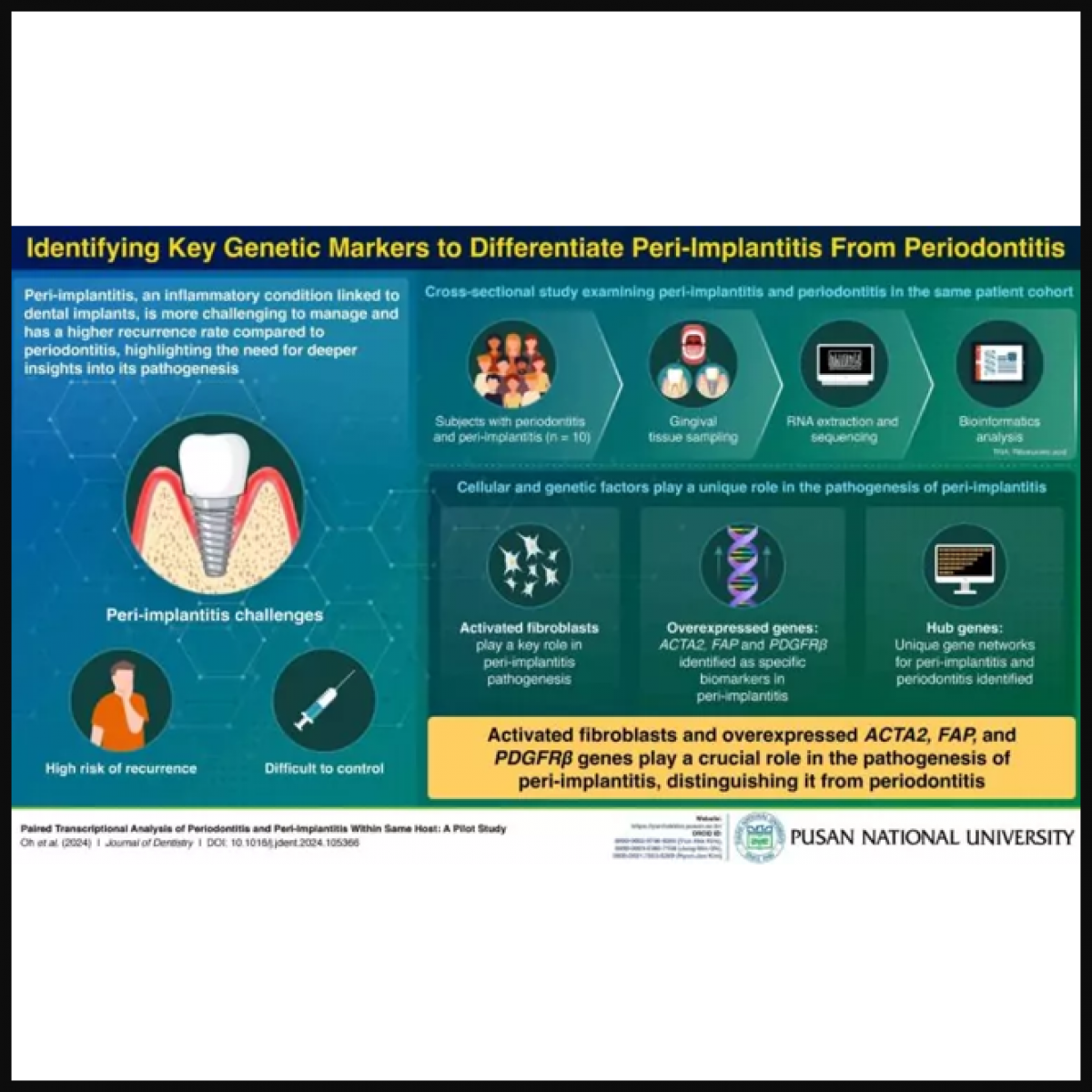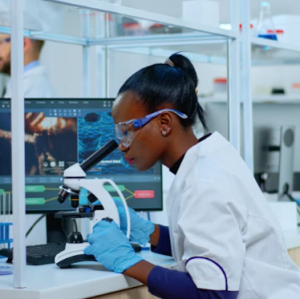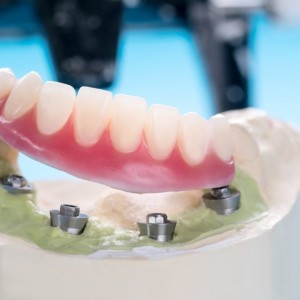
Pusan National University Researchers Discover Potential Biomarkers for Peri-Implantitis
The number of people receiving dental implants is increasing annually as more individuals become aware of the advantages of replacing missing teeth. However, this rise has also been accompanied by a growing prevalence of PI. While treatment protocols for PI often mirror those designed for managing periodontitis, they have proven to be less effective. Additionally, PI has a higher chance of recurrence than periodontitis, posing greater challenges for management.
Understanding the key differences in the pathophysiology of PI and periodontitis is essential for developing more specialized and effective treatments for PI. A significant breakthrough in efforts to identify these critical differences was made in the study, which uncovered a link between PI and activated fibroblasts. Activated fibroblasts are cells in the connective tissue that have started to proliferate abnormally. The study also identified three specific marker genes that were overexpressed in PI but not in periodontitis. This paper was made available online on October 1, 2024, and was published in Volume 151 of the Journal of Dentistry.
“This study provides essential insights into the role of activated fibroblasts as a distinctive factor in the pathogenesis of peri-implantitis versus periodontitis. Although peri-implantitis and periodontitis share clinical similarities, they exhibit distinct biological pathways. This research identifies three key biomarkers—ACTA2, FAP, and PDGFRβ—that are markedly overexpressed in peri-implantitis. These biomarkers have the potential to facilitate differential diagnosis and contribute to the development of peri-implantitis-specific therapeutic approaches,” explains Professor Yun Hak Kim, a lead researcher in the study.
To understand the genetic, immunological, and other physiological factors underlying PI and periodontitis, researchers collected gingival tissue from patients with both conditions. The samples were then processed, sequenced, and analyzed for RNA obtained from the gingival tissue. The study identified the three genes that could serve as disease-specific biomarkers for PI, which can help clinicians diagnose the condition and make more informed decisions regarding treatment.
Biomarker-based diagnostics could minimize misdiagnoses between peri-implantitis and periodontitis, thereby enhancing patient prognoses. By providing targeted treatment strategies for high-risk patients, particularly in peri-implantitis, this approach may contribute to reducing recurrence rates and improving overall therapeutic effectiveness. “These findings could drive significant advancements in clinical strategies for diagnosing and treating peri-implantitis,” notes Professor Kim.
While the treatment for periodontitis comprises mechanical methods to restore the structural integrity of teeth and various antimicrobial treatments, PI treatment follows a similar protocol. However, controlling the disease with this approach is highly challenging. The differentially expressed genes identified in the study could be pivotal in developing new treatment approaches for PI that target its unique pathophysiology.
“Over the next 5–10 years, this study’s findings could serve as a fundamental basis for the development of highly specialized, targeted therapies addressing peri-implantitis, specifically focusing on its unique biological and immunological characteristics compared to periodontitis,” concludes Professor Kim. This targeted approach could significantly contribute to extending the durability and success rates of dental implants, especially for patients at elevated risk of peri-implantitis due to underlying inflammatory conditions. Additionally, by elucidating the role of activated fibroblasts in peri-implantitis, this research offers valuable insights that could advance our understanding and treatment of other chronic inflammatory diseases with similar cellular mechanisms.
Source: www.pusan.ac.kr/eng/Main.do
 Related articles
Related articles
Editorials 04 November 2025
NIH grant helps ASOD researchers study TMD pain in adolescents
Adams School of Dentistry’s Caroline Sawicki, DDS, PhD, recently received an NIH-NIDCR R03 grant to study personalized treatment for temporomandibular disorder (TMD) pain in adolescents.
Silencing a receptor in prostaglandins reduces pain but allows inflammation to run its course in animal and cellular studies.
Market 15 September 2025
Drs. Anderson Hara, professor and director, Oral Health Research Institute (OHRI), and Grace Gomez Felix Gomez, assistant professor, dental public health and dental informatics, secured monumental...
Editorials 23 December 2024
Researchers at NYU College of Dentistry and NYU Grossman School of Medicine are closer to understanding what drives the autoimmune disorder Sjögren’s disease, thanks to new discoveries about the...
The taste buds of the tongue contain bundles of specialized cells bearing sensors that detect chemical attributes of food
 Read more
Read more
Prosthodontics 17 November 2025
The purpose of this report is to describe a new technique to fabricate and deliver an implant-supported fixed prosthesis to the patient on the day of surgery, and to propose a protocol for the...
Editorials 17 November 2025
The Langkamp Allison Award recognizes a Pitt Dental Medicine third-year dental student interested in pursuing a career in dental education.
Products 17 November 2025
VELMENI today unveiled VELMENI Voice, an AI-driven voice recognition tool designed to transform periodontal charting and clinical documentation.
News 17 November 2025
Angelalign Technology Inc. (6699.HK) (“Angel”) recently announced the expansion of its flexible iOrtho platform to include direct integration with the Dexis, Shining 3D, and Panda scanners.
News 17 November 2025
Following the first FDA clearance for technology that measures internal mobility in teeth, Perimetrics CEO and Chairman Robert Hayman is once again leading dentistry into a new era with InnerView, a...














